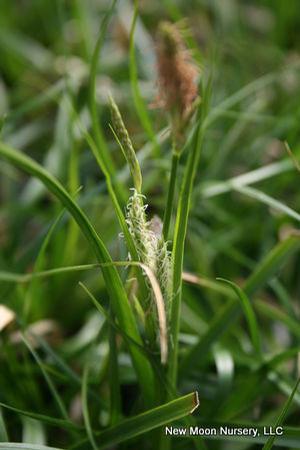Printed at http://www.newmoonnursery.com/index.cfm/

Cherokee sedge is an evergreen sedge for wet spaces, such as low spots, pond and stream edges, and rain gardens.
Carex cherokeensis
Cherokee sedge
Native to North America
FIRST IMPRESSIONS: Carex cherokeensis is a robust perennial sedge that forms attractive slowly spreading clumps. The narrow leaves are shiny, upright and are often evergreen. In late spring greenish white scaly flower spikes dangle above the gracefully shaggy foliage. The flowers transition into pendant wheat-like seed clusters. This sedge is planted most often in woodland or shade gardens with average, moist or wet soil. Plants are also at home in sunny meadows and seasonally flooded open woodlands.
HABITAT & HARDINESS: Carex cherokeensis is native to the southeastern and southcentral United States from Missouri east to North Carolina and south to Florida.
Plants are indigenous to floodplain forests, dry-mesic calcareous woodlands, forests with acidic loamy soils, swamp forests, wet clearings, slopes above streams or creeks, acid seeps, dolomitic glades, blackland prairies and disturbed sites. This sedge is reported to be rare or endangered in many parts of its range.
Hardy from USDA Zones 6-9.
PLANT DESCRIPTION: Carex cherokeensis grows in compact mounds of arching glossy foliage. Plants gradually form dense colonies from short underground rhizomes.
Foliage is fine textured and deep green. Blades are generally 6-12” and about ¼” wide. The narrow grass-like leaves are evergreen through most of the range.
In spring culms rise above the foliage bearing several drooping pale green flower spikes. As seed begins to form, the spikes evolve to a pleasing straw color and finally golden brown.
This sedge is up to 2’ tall with a 2-4’ spread.
CULTURAL & MAINTENANCE NEEDS: Carex cherokeensis is a tough heat tolerant sedge. Plants prosper in shade or part shade but also grow successfully in sun. Moist soil is preferred but plants will tolerate average soils, drought and wet sites.
This clump forming perennial is indigenous to both acid and alkaline soils and is adapted to heavy clay.
Plants are pest resistant and unpalatable to deer and other herbivores.
In garden situations, plants should be cut to the ground during late winter.
LANDSCAPE USES: Carex cherokeensis is a valuable Groundcover or Edging Plant for a Shade Garden. This sedge is useful in meadows and is a good component for a Grouping or Mass Planting. Plants provide Erosion Control and Winter Interest and are appropriate for Deer Resistant Plantings, Low Maintenance Plantings, Rain Gardens, Restoration Projects and Wildlife Gardens.
Carex cherokeensis is a great native substitute for the popular Asian groundcovers Liriope muscari and Ophiopogon japonicus.
COMPANION & UNDERSTUDY PLANTS: Carex cherokeensis is an extremely versatile plant. Suitable companions can range from prairie plants to wetland species or woodland perennials depending on the site conditions. A few possibilities are: Aster novae-angliae, Chasmanthium latifolium, Penstemon digitalis, Spigelia marilandica, and Sorghastrum nutans.
Carex pensylvanica is similar in appearance and cultural needs but is a little coarser textured and slightly larger.
TRIVIA: This sedge is fairly common in Blackland Prairies and Savannas of the Gulf Coastal Plain.
Over 1500 species of Carex grow in a variety of habitats (often moist to wet areas) throughout the world. Identification of individual species can be very difficult. Generally the plant must be in bloom and a magnifying glass must be nearby.
Height:
12-18 inSpread:
1 ftSpacing:
12-18 inUSDA Hardiness Zone:
6-9Bloom Color:
GreenCarex cherokeensis Characteristics
Attracts Wildlife
- Pollinators
- Songbirds
Exposure
- Full Sun to Full Shade
Deer Resistant
- Deer Resistant
Flowering Months
- June
- May
- April
Grass Season
- Cool Season Grass
Groundcover Foot-Traffic Tolerances
- Moderate
Lawn Replacement or Groundcover
- Groundcover
- Lawn Replacement
Soil Moisture Preference
- Wet to Moist
Interesting Notes:
For more information on this plant, visit the USDA PLANTS Database: http://plants.usda.gov/java/profile?symbol=CACH3
